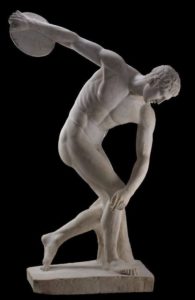Unit 2 was about the emergence from art being more symbolic and representative of the ruling class to being more literal and representative of the common individual. Despite this change, art still retained its emphasis on symbolism, only its treatment of it was different. In the beginning of the unit, Ancient Egypt and Mesopotamia was the focus. The ruling class was depicted in its art and the way art was handled remained the same in these societies for hundreds of years, with a ruler revolutionizing the art form every now and then before art would return back to how it always was. In these early societies, rulers and gods were always depicted as larger than the civilians and neither the civilians or their superiors were ever rendered in a realistic fashion.
The unit moved on to a visit at the Brooklyn Museum. During the exploration of the Soul of A Nation exhibit, we were tasked with the examination of a work of art as well as an examination of an ancient work of art. Although it wasn’t part of the assignment, it was very easy to explain how different art has become within our world. The Soul of A Nation was completely comprised of art that focused on the individual and the power and depth of the common man. This is in sharp contrast with the ancient art we described. Although there were many other exhibits such as Syria Then and Now: Stories from Refugees a Century Apart, One: Do Ho Suh, Half the Picture: A Feminist Look at the Collection, Something to Say: Brooklyn Hi-Art! Machine and many more, Soul of A Nation stood out the most to me. I like the fact that it acknowledged that there are different types of nations (this one being a cultural one) that may not be visible to everyone else but still exists nonetheless. It felt like something that someone within this nation could instantly understand and feel at home with.
The unit continued on with the change to Greek and Roman art. Although there was a focus on rulers (the depictions of Augustus Caesar and Julius Caesar were important pieces of art from the Roman world), much of the focus was placed on the commoner. People with normal day jobs and day jobs that didn’t pay much money were depicted and with great honor and detail. This was due to the rise in the humanist philosophy. The focus was placed more on man as being powerful as opposed to gods or the ruling class. Symbols used to show power were no longer symbols of the gods but were instead the symbols of man. Realism was created to show this power; the more realistic the art, the more praise is given to mankind. This philosophy is related to how art is used today, as seen in the modern exhibits from the Brooklyn museum. Our philosophy always bleeds into the art we create whether we are aware of it or not.

